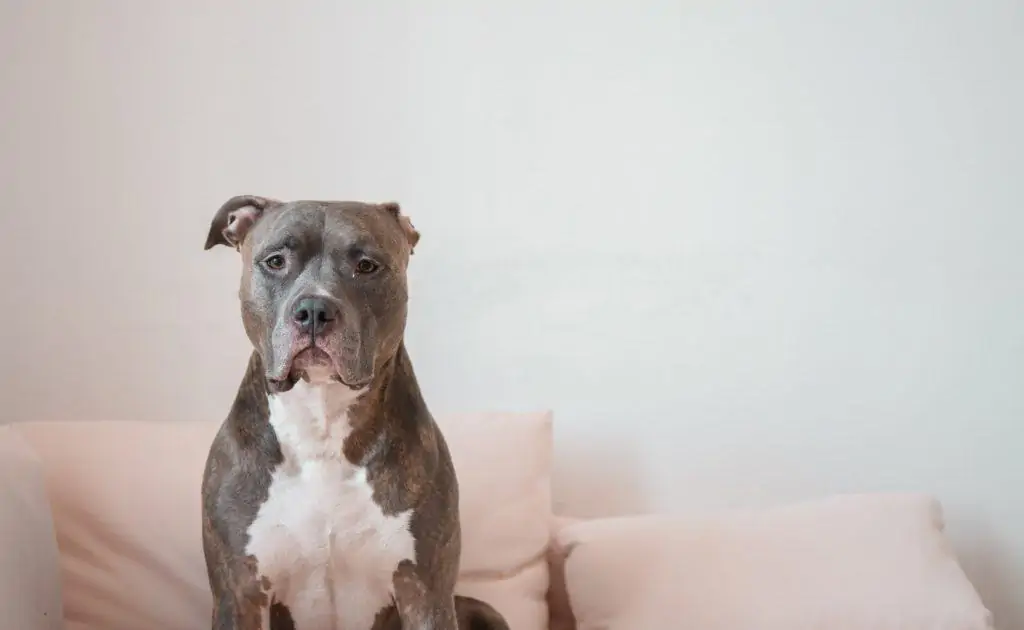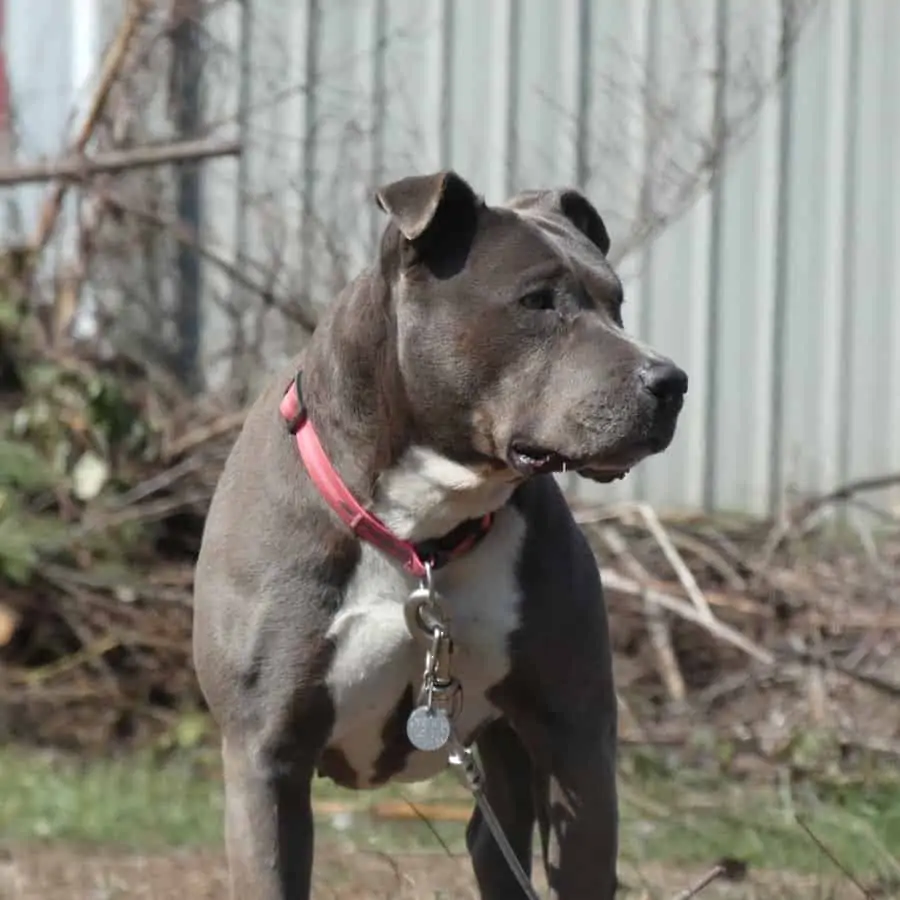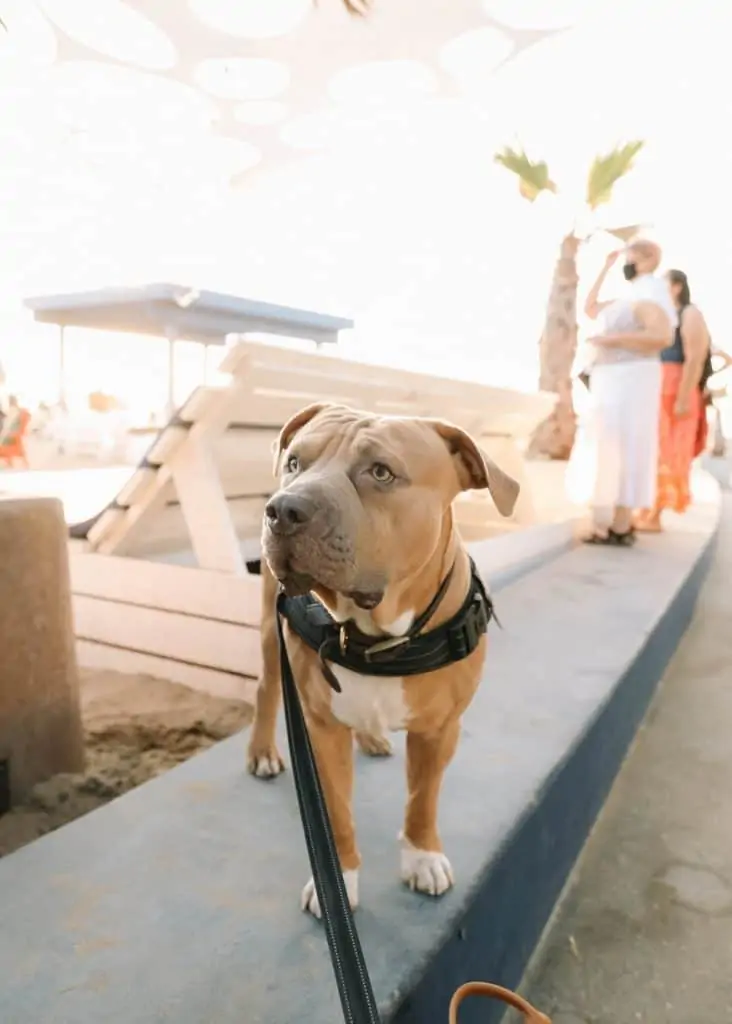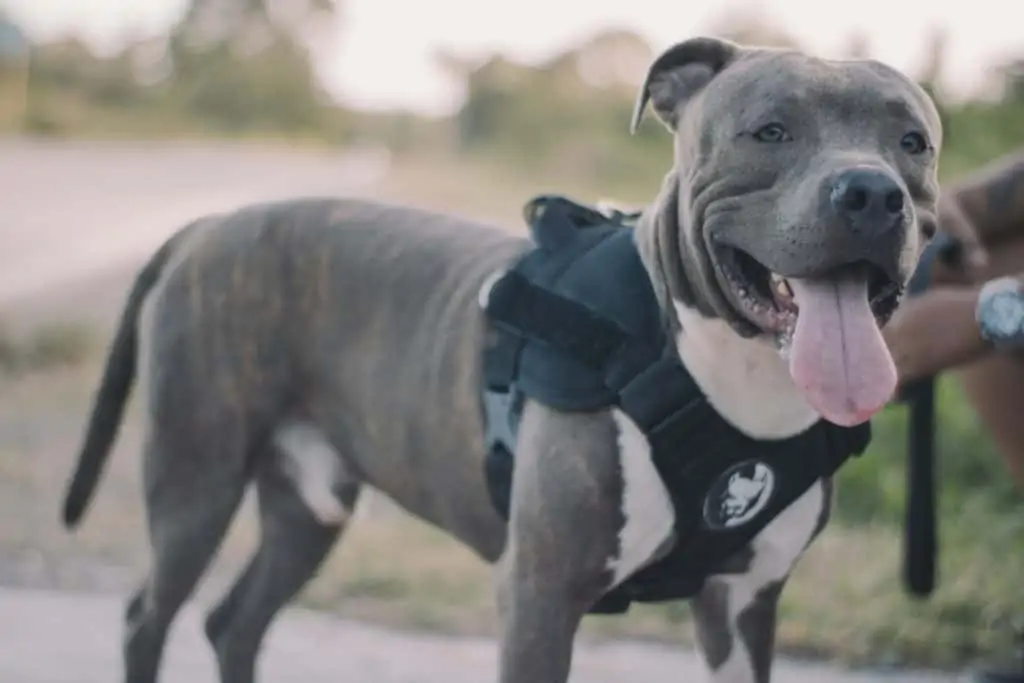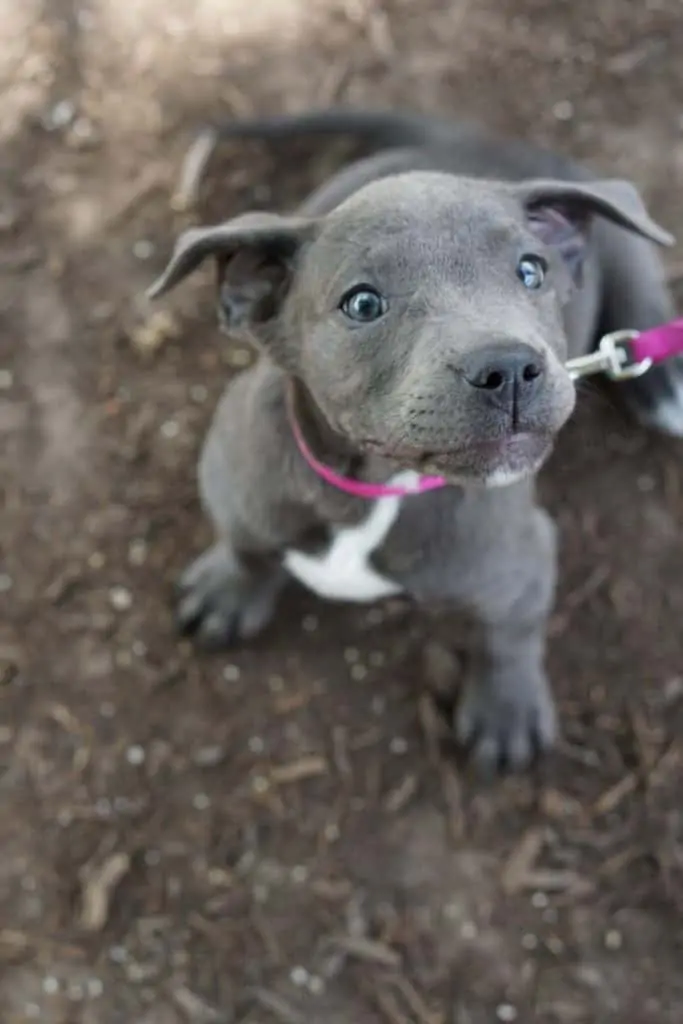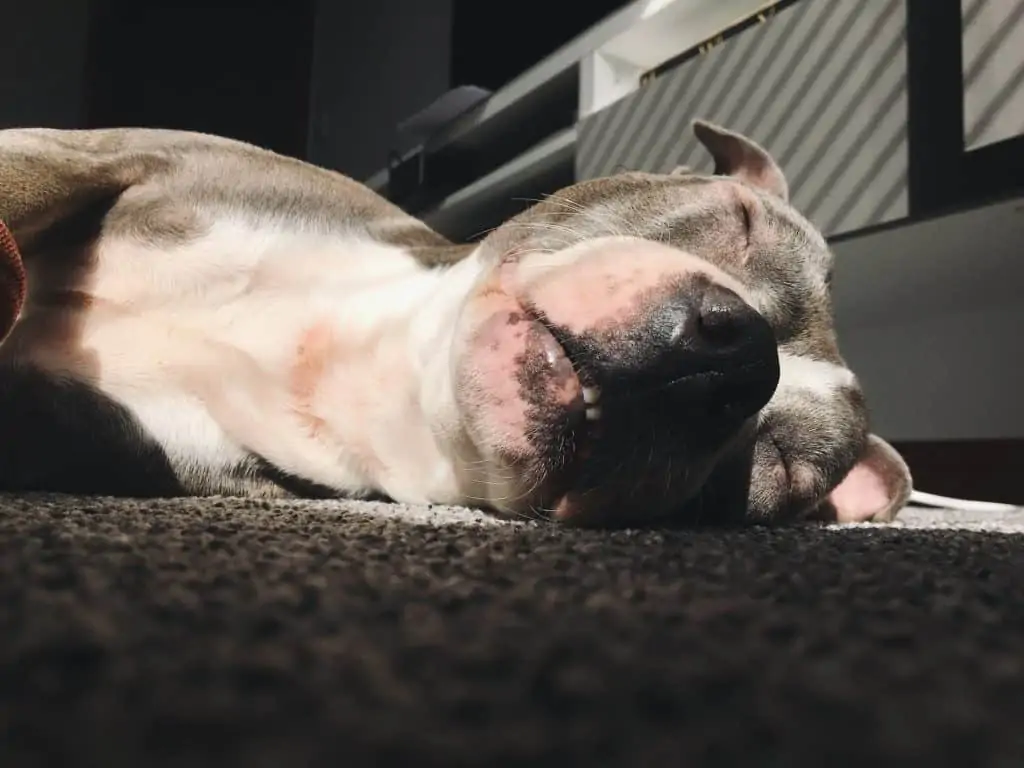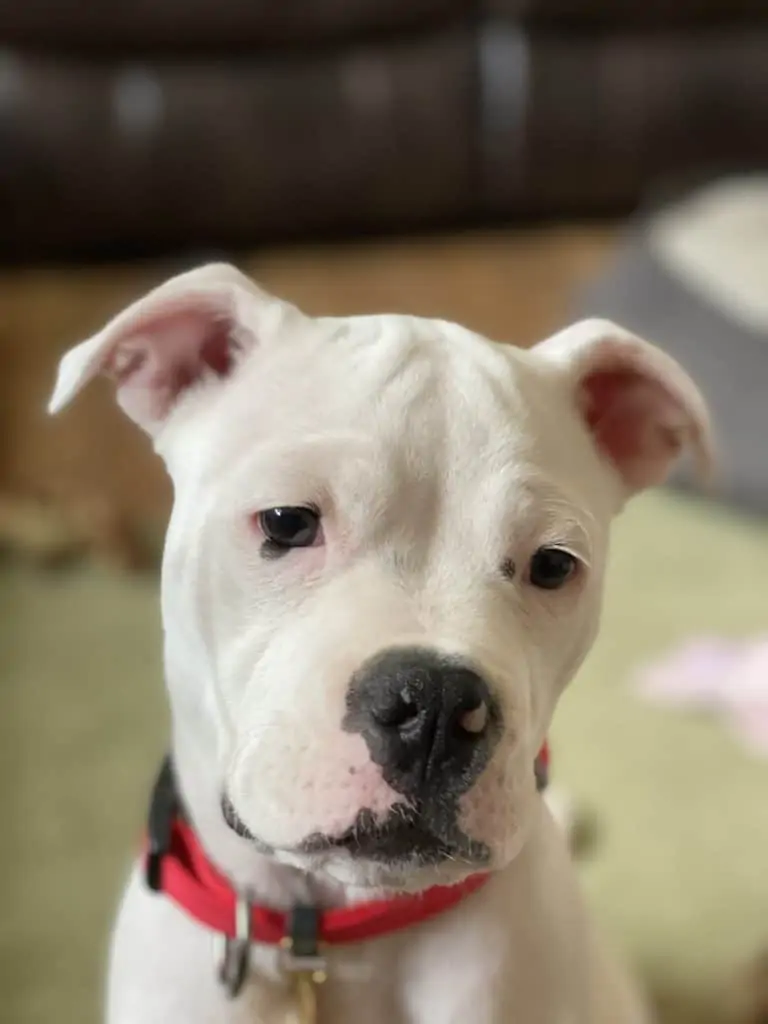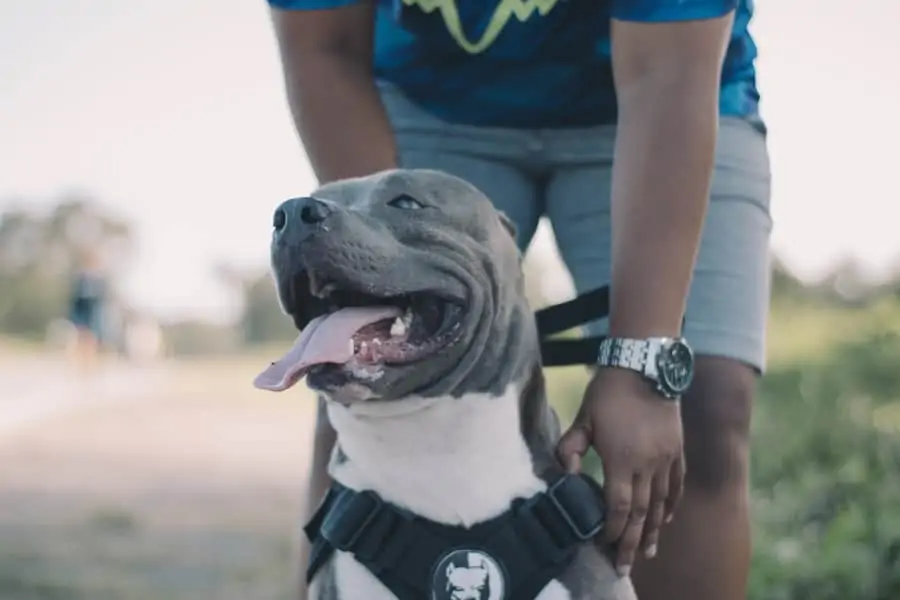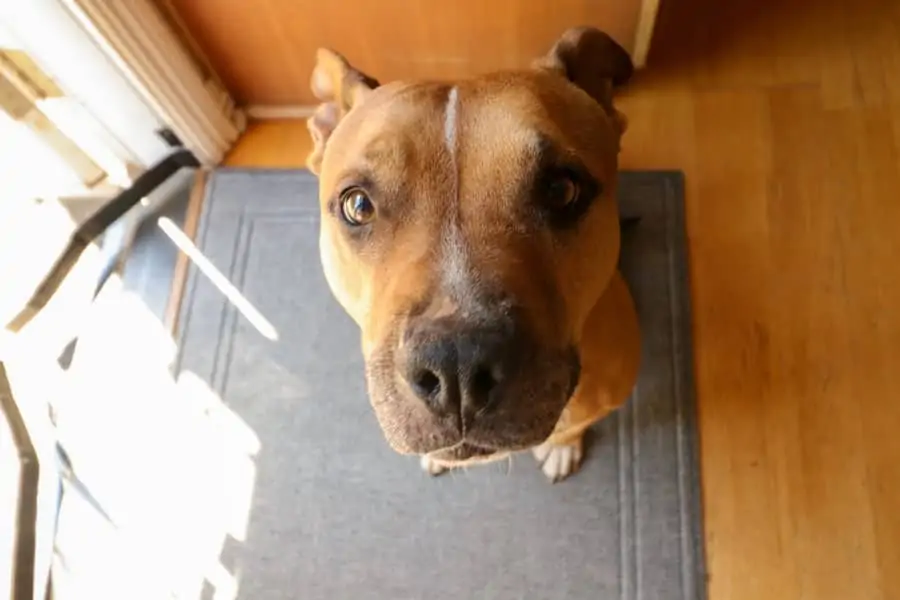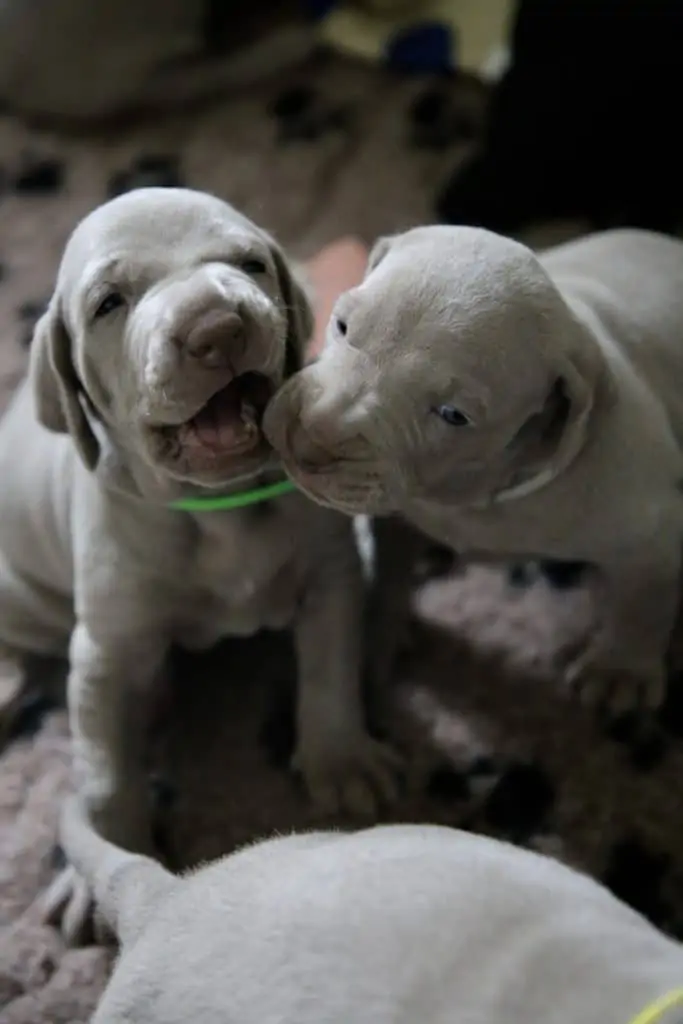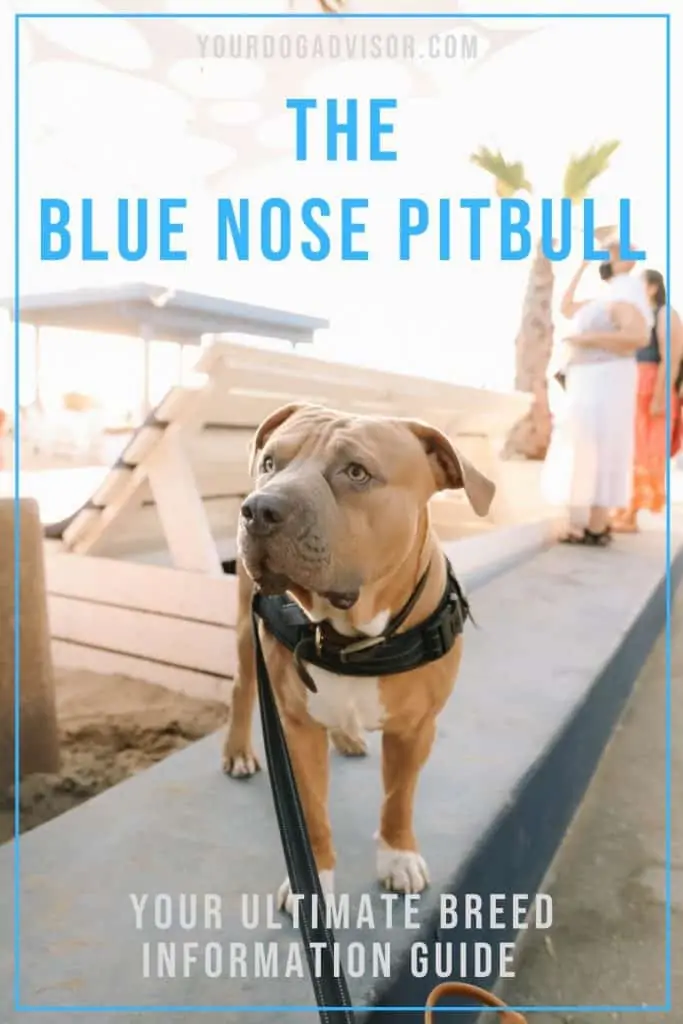The term “Pitbull” is a broad term used to describe several bully breeds in the United States. That said, there is a lot of confusion surrounding different types of Pitbulls and Pitbull breeds, with many considering breeds to be different based solely on the color of their coat or nose.
Today’s article is all about one such Pitbull – The Blue Nose Pitbull. Today, we are discussing this rare Pitbull type and learning about what makes him different from other types of dogs.
Let’s begin.
Contents
The Blue Nose Pitbull – A Breed Overview
The Blue Nose Pitbull is most commonly an American Pit Bull Terrier.
The Blue Nose Pitbull is not necessarily a breed, but is a type of Pitbull with a certain color nose and coat. Blue Nose Pitbulls are most commonly seen in American Pitbull Terriers, but they can also come as Blue Nose American Staffordshire Terriers, Blue Nose American Bulldogs, and Blue Nose Staffordshire Bull Terriers.
All four of these dogs are categorized as true Pitbulls. However, since the Blue Nose Pitbull is most commonly seen in American Pitbull Terriers, we are going to cover this breed in particular.
The Blue Nose Pitbull – An American Pitbull Terrier Overview
Height: 17 – 21 Inches
Weight: 30 – 60 Pounds
Blue Nose Pitbull Coat Colors: Blue, Grey, Blueish-Grey and White Chest, and Sometimes Fawn, Tan or White
Coat Type: Short, Smooth, Shedding
Health Issues: Allergies, tumors, skin cancer, hip dysplasia, elbow dysplasia, knee issues, thyroid disease, Ichthyosis, cataracts, Bloat, heart disease and cerebellar ataxia.
Lifespan: 8 – 15 Years
Temperament: Devoted, affectionate, playful and adoring. However, these dogs may not get along well with other dogs or animals.
Clubs That Recognize The Blue Nose Pitbull:
- The American Dog Breeders Association
- Golden State American Pitbull Terrier Club of California
- The United Kennel Club
Blue Nose Pitbull History
When it comes to a breed’s history, there is perhaps none as famous as the Pitbull. Sadly, Pitbulls have a bloody origin that revolves around dog fighting and bull baiting. While this is also true for the Blue Nose Pitbull, there are also lesser known jobs this dog excelled in that helped his family and property a great deal.
In fact, like many intelligent and prey-driven dogs, the Blue Nose Pitbull and his other Pitbull counterparts were also popular farm dogs. They patrolled their property catching small vermin and helped protect livestock from predators.
This is one of the reasons Blue Nose Pitbulls in particular are known to have such a strong prey drive, and one of the reasons they may also not be ideal dogs in homes with other pets.
How Did The Blue Nose Pitbull Get A Blue Nose? Let’s Talk Genetics
Blue Nose Pitbulls can be any breed of Pitbull with a recessive gene that makes their nose blue.
Blue Nose Pitbull dogs are rare, which is one of the reasons they are so highly sought after by breed enthusiasts. But what makes them so hard to come by?
The gene that makes the Blue Nose Pitbull have a blue nose and (oftentimes) a blue coat is a recessive gene, meaning it is less likely to present itself in a litter than other dominant genes.
This means that in order to guarantee a litter of Blue Nose Pitbull, a breeder will have to deliberately breed two Blue Nose Pitbulls together. This can be expensive and time consuming, and even then genetics are genetics and there is no guarantee.
Furthermore, breeders who are not careful or do not follow responsible breeding practices may wind up breeding Blue Nose Pitbulls that are unhealthy. Others may inbreed in order to keep the blue gene going, which can further exacerbate serious health complications in litters.
For this reason, if you’re looking to get your hands on a Blue Nose Pitbull, your best bet is to go through reputable sources who have a history with breeding this type of dog and who understand the importance of responsible breeding practices.
Sadly, even Pitbulls who are bred responsibly and carefully can still wind up with a long list of health issues, which can make raising them not only financially trying, but also emotionally trying as well.
Unfortunately, because Blue Nose Pitbulls are rare, many breeders ignore their potential health issues and opt to sell Blue Nose Pitbull puppies for thousands of dollars, ignoring the amount of adult Blue Nose Pitbulls already available for adoption.
Not only does this exasperate potential health issues, as we mentioned above, but it can also lead to an overwhelming number of Blue Nose Pitbulls in shelters. As you may or may not know, Pitbulls and other Bully breeds like them are often the first to be surrendered to shelters and the first to be put down.
This is due to the incredible overcrowding in shelters and the generations of breed discrimination, breed bans and fear associated with the Pitbull dog in general.
And with that noted, it’s time to discuss Pitbulls and potential aggression. Keep reading.
Pitbulls and Dog Aggression – What You Should Know
Blue Nose pitbulls are not considered any more or less aggressive or unpredictable than other pitbull types, though they are often not fond of other dogs.
The Blue Nose Pitbull is a people-oriented dog who is devoted to his family and gentle with children. However, this is also a dog with an incredible prey drive and a dog who has been found to have an increased likelihood of aggression towards other dogs and animals.
While Pitbulls are not considered more or less aggressive or unpredictable than any other breed, their jaw strength is something that makes them more dangerous should they choose to bite.
This means that while all dogs have the potential to bite, there is a significantly higher mortality rate when it comes to Pitbull bites than other breeds. This is certainly something that potential Blue Nose Pitbull owners should take into consideration when choosing to invest in the breed, and careful socialization and training practices should be implemented early on.
Even then, the Blue Nose Pitbull is famous for his prey drive, and he is known to be disproportionately aggressive towards other dogs in general.
That said, many Blue Nose Pitbulls can get along well with other dogs they are raised with, although it’s still wise that owners monitor their dogs together and not leave them alone and with free range of the house during the day.
If you do plan on raising a Blue Nose Pitbull along with another dog in the home, we suggest utilizing crates and crate training your Blue Nose Pitbull to ensure he is safe and secure while you are not able to monitor him with his other canine siblings.
One of the crates we recommend for your Blue Nose Pitbull is listed below.
MidWest Homes For Pets ICrate
No products found.
The iCrate by Midwest Homes for Pets is a sturdy, durable crate that folds easily for storage but is strong enough to keep your Blue Nose Pitbull safe and secure. You can order it with a single door or a double door to make entry and exit easier.
The crate is designed to be safe and comfortable for your Blue Nose Pitbull, and you can even opt to order crate covers and bedding to fit into it to ensure the crate is nice for your dog.
Crating is sometimes considered cruel by well-meaning but uneducated dog lovers. The truth is, crate training your dog can actually be highly beneficial and decrease anxiety, reduce destructive behaviors, and provide your dog with a safe space that he feels happy and content in.
The trick is to properly crate train your dog at an early age to ensure his crate is a place he enjoys being. To do this, refrain from making your dog’s crate a place of punishment or fear. Fill his crate with toys and things he loves, and leave it open for him to come and go freely in during the day while you are home.
Crate training should begin early on during your Blue Nose Pitbull’s puppyhood, although it is possible to crate train an adult Pitbull as well.
So long as crate training is done properly, it can work wonders to ensure your Blue Nose Pitbull is safe, healthy and happy.
Pitbull Temperament – Raising A Blue Nose Pitbull With Children
Blue Nose Pitbulls are generally friendly and do well with children when properly trained and socialized.
Overall, a properly trained and socialized Blue Nose Pitbull has the potential to make a fabulous pet in the right household. They get along well with children and other people, and even enjoy strangers.
For this reason, the Blue Nose Pitbull will not make a good guard dog. Many people get a Blue Nose Pitbull thinking the dog will deter intruders, but the truth is that the Blue Nose Pitbull is one of the most friendly companion dogs around people.
But what about your Blue Nose Pitbull with children?
While they may not get along with other pets in the home, Blue Nose Pitbulls are famously gentle and affectionate with youngsters. That said, it’s still important to monitor children around your Blue Nose Pitbull to ensure everyone is getting along safely.
Teach children basic canine body language so that you all may better understand when your dog is feeling happy, anxious, stressed or fearful. Nip problematic behaviors in the bud as soon as you notice them, like resource guarding behaviors, for instance.
And this is where training and socializing comes in.
Tips On Training and Socializing A Blue Nose Pitbull
Training and socialization should begin at an early age and be consistent throughout your Blue Nose Pitbull’s lifetime.
All dogs require routine training and socialization, and the Blue Nose Pitbull is no exception. This is especially true if you plan on raising your Blue Nose Pitbull around other pets, even if they are just other pets in the neighborhood.
To properly socialize your Blue Nose Pitbull, make sure and introduce him to as many new people, places, sights, sounds, experiences, and other dogs as possible at an early age.
Let him join you on as many outings as you can, and work with him on leash training and proper leash manners. Blue Nose Pitbulls are incredibly muscular and strong, and their prey drive is very high. Working early on socialization and training with a leash can help reduce pulling and aggression towards other dogs on walks.
And speaking of training, the Blue Nose Pitbull is devoted and eager to please dog. This means that training him is a joy, especially when the proper techniques are implemented. Refrain from punishing or scolding your Blue Nose Pitbull during training sessions, as these dogs are sensitive and will shut down if they feel they have displeased you.
However, we should note that many Pitbull dogs are known to be stubborn, so an owner should be firm and consistent, yet also loving and encouraging.
Quality training treats can help keep your Blue Nose Pitbull’s attention during training, like the below training treats by Marrick.
Merrick Power Bites Training Treats
No products found.
High quality training treats like these Merrick treats are ideal for training for a number of reasons. They are small, highly palatable, soft and smelly, and your Blue Nose Pitbull will be eager to work hard to get even a small nibble.
The above treats are also healthy. They contain real beef and animal protein and are free of any unnatural ingredients or additives. In fact, they are all natural and grain free. Best of all, these treats are ideal for Blue Nose Pitbulls, who can be sensitive to certain foods and have allergies to treats with poultry.
And on the topic of allergies, it’s time to discuss your Blue Nose Pitbull’s health and overall lifespan.
Blue Nose Pitbull Health Issues and Life Expectancy
Like all dogs, Blue Nose Pitbulls can be susceptible to serious health issues, especially if they are not obtained through a reputable source.
Blue Nose Pitbulls can be long-lived dogs with a decent lifespan of between 8 and 15 years. However, during this time the Blue Nose Pitbull can suffer from a variety of health conditions that range from mild to severe.
You can combat potential health issues by ensuring you obtain your Blue Nose Pitbull from a reputable source, but even then there are no guarantees.
For that reason, it’s best to have a good idea of the health issues your Blue Nose Pitbull could be prone to. These issues include but are not limited to:
- Allergies
- Tumors
- Skin Cancer
- Sunburns
- Heat Intolerance
- Torn ACL
- Hip Dysplasia
- Thyroid Disease
- Gastric Dilation – Volvulus (Bloat)
- Cataracts
- Ichthyosis
- Cerebellar Ataxia
- And Heart Disease
What You Should Know About Bloat in Your Blue Nose Pitbull
Bloat, also known as Gastric Dilatation – Volvulus or GDV, is a serious and life threatening condition that is common in large, deep chested dogs like the Blue Nose Pitbull. This condition can come on suddenly or be triggered by certain activities like eating or drinking too much too quickly.
Bloat occurs when air fills the stomach, causing organs to flip. This sends the dog into shock and requires immediate medical attention. Since Bloat can be life threatening and since it is a prominent problem for Blue Nose Pitbulls, it’s important to know the symptoms of this condition and keep an eye out for it.
Common symptoms of Bloat in a Blue Nose Pitbull include excessive panting, drooling, lethargy, extended abdomen, unproductive vomiting, pacing, and eventual collapse.
What You Should Know About Skin Issues in Your Blue Nose Pitbull
Blue Nose Pitbulls are super susceptible to skin issues and allergies that can be exasperated by an improper diet. They are also more prone than many breeds to suffer from heat intolerance and sunburn.
When out and about in the sun, it’s a good idea to provide your Blue Nose Pitbull with protective clothing or doggy sunscreen, and to ensure he takes plenty of breaks in a shaded area. If you leave your dog outside for an hour or two, be sure he has access to plenty of cool drinking water and a shady space to lay.
To reduce skin allergies in your Blue Nose Pitbull, make sure he is on quality dog food. Limited ingredient diet dog foods and hypoallergenic dog foods can help reduce skin issues and itchiness. You also have the option of choosing raw dog food, dry dog food or wet dog food.
One of our favorite dog food brands for Blue Nose Pitbulls with skin allergies is listed below.
Blue Buffalo Basics Limited Ingredient Diet Dog Food
No products found.
Blue Buffalo is made with quality ingredients and free of any additives or fillers. Most importantly, the above Blue Buffalo dog food is a limited ingredient diet which is ideal for dogs with sensitives and skin allergies.
This dog food comes in a few different recipe options, but we recommend the seafood or salmon option for your Blue Nose Pitbull. This recipe is rich in DHA and fatty acids that can promote skin and coat health.
Blue Buffalo Basics is also free of chicken, which can exacerbate skin and allergy issues in any dog. This food is also free of corn, soy, wheat, gluton, by-products, fillers and dyes.
You can also help reduce certain skin issues and allergies in your Blue Nose Pitbull by keeping up with routine grooming practices.
Keep reading to learn more.
How To Groom A Blue Nose Pitbull
Because of their short, smooth coats, Blue Nose Pitbulls are relatively easy to groom, though grooming should be done carefully to help reduce skin issues.
Even though your Blue Nose Pitbull has a short coat, grooming will still need to be routinely implemented to help reduce skin issues and allergies, as we mentioned above.
The Blue Nose Pitbull does shed year-round, and he sheds most during shedding season in spring and fall. Still, he should only need occasional brushing with a deshedding comb.
Special attention should be paid to your Blue Nose Pitbull’s eyes and ears during grooming sessions, and cleaning his ears can help reduce buildup and debris that may lead to ear infections.
Your Blue Nose Pitbull should also have his teeth cared for on a routine basis, as dental disease is one of the leading causes of health issues in dogs of all breeds across the spectrum.
Like all dogs, the Blue Nose Pitbull should have his nails trimmed on occasion to keep them from growing too long and breaking during play or exercise.
The Blue Nose Pitbull doesn’t require too much bathing, though he should have an occasional bath once every few months. Bathing your Blue Nose Pitbull too often can increase the potential for skin issues as doing so can strip his skin of the natural oils it produces to protect his coat.
When you do bathe your Blue Nose Pitbull, be sure to use a quality shampoo for dogs. Because Blue Nose Pitbulls are so sensitive, we recommend using a hypoallergenic dog shampoo like the one listed below.
Burt’s Bees Hypoallergenic Dog Shampoo
No products found.
Burt’s Bees makes a quality dog shampoo for dogs with skin sensitivities like the Blue Nose Pitbull.
The above dog shampoo is made with honey and shea butter that not only helps to reduce skin sensitivities but also soothe them. The ingredients are all natural, although you should be careful with this shampoo because it can irritate your dog’s eyes.
Your Blue Nose Pitbull And The Importance of Exercise and Mental Stimulation
Without proper exercise, Blue Nose Pitbulls can become bored and destructive.
As an athletic and muscular dog, it’s no surprise that the Blue Nose Pitbull is going to require routine exercise and mental stimulation.
These dogs are highly active and intelligent, and if their mental and physical needs are neglected they can become bored and destructive.
Experts recommend your Blue Nose Pitbull partake in at least 60 minutes of exercise a day. This exercise needs can be met with routine walks, jogs, hikes or free play time in the backyard.
Since the Blue Nose Pitbull does not usually do well with other dogs, we would not recommend taking your Blue Nose Pitbull to a dog park.
Instead, if you want to practice free playtime with your Blue Nose Pitbull, we suggest doing so in a securely fenced backyard. Be sure the fence is at least six feet tall and that the bottom of your fence is reinforced. Blue Nose Pitbulls are diggers, and dig especially if they become bored.
When walking your Blue Nose Pitbull, be sure to invest in the right equipment.
PetSafe Easy Walk Deluxe Harness
No products found.
The proper walking equipment can make all the difference when it comes to walking your Blue Nose Pitbull. This is especially true considering how strong this dog is.
For this reason, we recommend using the above PetSafe Easy Walk Deluxe Dog Harness. This is a no-pull harness that helps redirect pulling dogs back to you without putting harmful pressure on their throats or tracheas.
These kinds of harnesses are excellent alternatives to prong collars or choke chains, and have even been shown to be much more effective in training your dog without the use of pain or punishment.
When used in conjunction with treats and early leash training, the above dog harness can help ensure your Blue Nose Pitbull is happy and safe during walks.
Along with routine exercise, the Blue Nose Pitbull will also require consistent mental stimulation. Puzzle toys and training throughout his lifetime can help keep him engaged, as can utilizing strong toys like KONGS and other tough toys that can stand up to your Blue Nose Pitbull’s powerful jaws.
Do You Have The Ideal Home Type For A Blue Nose Pitbull?
Blue Nose Pitbulls do best in homes with enough space for them to play and will enjoy having a backyard.
The ideal home type for a Blue Nose Pitbull will be a home with an active owner or family who has a basic understanding of the Pitbull breed.
Novice dog owners may find themselves overwhelmed with the amount of energy these dogs have and their need for consistent exercise and play. However, in the right home, Blue Nose Pitbulls make fabulous companions.
It’s best to ensure they are the only dog in the house and to implement proper training and socialization early on to reduce chances of dog-on-dog aggression when out and about.
The Blue Nose Pitbull can also suffer from some serious health issues, so owners should be prepared for this as well and may even consider investing in pet health insurance.
Blue Nose Pitbulls will also enjoy having a backyard where they can run and play in freely. These are not ideal apartment dogs, as their energy level will not be conducive to these smaller spaces.
Tips On Finding The Healthiest Blue Nose Pitbull Puppy or Rescue
You’re most likely to find the healthiest puppy or rescue dog when going through reputable sources.
Blue Nose Pitbulls can be notoriously unhealthy, especially if they are obtained through disreputable sources. Avoid going through backyard breeders, unqualified online sellers, or those promising Blue Nose Pitbulls at an extravagant price or a price that seems too good to be true.
On average, Blue Nose Pitbull puppies range from $1,000 to $3,000, but this price can vary depending on your location and the breeder you go through. Be sure to go through breeders who can provide you with certificates of health proving their puppies have been screened and cleared of any serious issues.
We also suggest considering adopting a Blue Nose Pitbull from a rescue or shelter you trust. Remember, there are plenty of Blue Nose Pitbulls available for adoption and looking for a good and loving home.
When going through a rescue, prices range from $250 to $750 dollars. Many rescues will also provide you with a free initial vet exam and many may have had their dogs undergo behavioral testing before placing them for adoption.
And there you have it – everything you should know about the Blue Nose Pitbull. We hope this has been a helpful guide on this beautiful and rare dog and that you now have a better idea as to whether or not this dog is right for you.
Best of luck and thanks for reading.
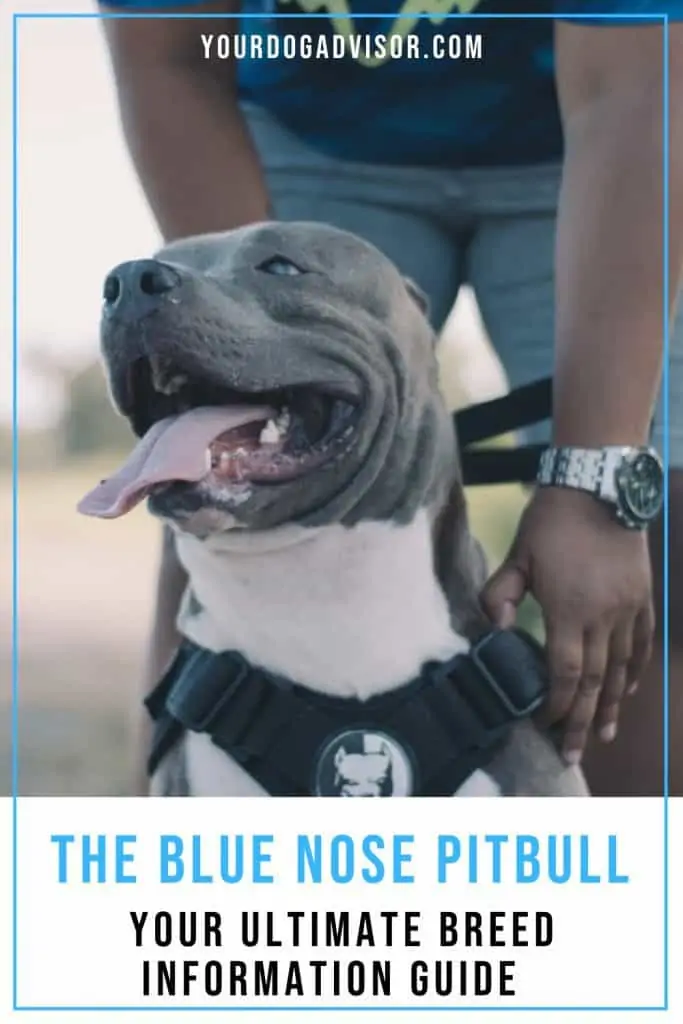

Jen Jones is a professional dog trainer and behavior specialist with more than 25 years of experience. As the founder of ‘Your Dog Advisor’ and the ‘Canine Connection’ rehabilitation center, she applies a holistic, empathetic approach, aiming to address root causes rather than merely treating symptoms.
Well known for her intuitive and compassionate approach, Jen adopts scientifically-proven, reward-based methods, encouraging positive reinforcement over punishment. Jen specializes in obedience training, behavior modification, and puppy socialization. Her innovative methods, particularly in addressing anxiety and aggression issues, have been widely recognized. Jen has worked with many of the world’s leading dog behaviorists and in her free time volunteers with local animal shelters and rescue groups.
